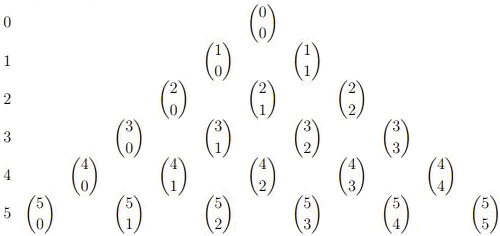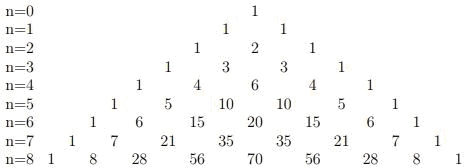
Concept explainers
Show that .
To prove: To show that and .
Answer to Problem 45AYU
Generally, in the row, these entries are and , so this is why we always get for those entries.
Explanation of Solution
Given:
It is asked to prove that and .
Formula used:
The symbol is defined as
Therefore,
Therefore, .
APascal’s triangle is a sequence of rows that form a triangle that gets wider as we go down. Let’s label the rows as etc. For example:

Here 0 row is formed by taking the element . The 1 row is listing the elements and . The 2 row is listing the elements , and and so on.
The n row becomes . Further position the elements and so that the element is between them and one level above them.
As it stands, it is quite cumbersome to compute the rows of Pascal’s triangle. For example, to compute the 8 row, we have to compute each element from . Instead of doing such hard work, let’s look at the table with the numbers computed up through the 8 row and look for patterns

Note that there are a few easy things to observe.
First, the entries on the left and right edges are alwalys 1. This is easy to explain, because they are always of the form or and
Further, the entries next to the edges in each row just give the number of the row. For example, in the 6 row, the entries next to the 1’s on the outer edge are 6 and 6. This is because they represent and . More generally, in the row, these entries are and , so this is why we always get for those entries.
Chapter 12 Solutions
Precalculus Enhanced with Graphing Utilities
Additional Math Textbook Solutions
Thinking Mathematically (6th Edition)
Introductory Statistics
A Problem Solving Approach To Mathematics For Elementary School Teachers (13th Edition)
Elementary Statistics (13th Edition)
Basic Business Statistics, Student Value Edition
Algebra and Trigonometry (6th Edition)
- 74. Geometry of implicit differentiation Suppose x and y are related 0. Interpret the solution of this equa- by the equation F(x, y) = tion as the set of points (x, y) that lie on the intersection of the F(x, y) with the xy-plane (z = 0). surface Z = a. Make a sketch of a surface and its intersection with the xy-plane. Give a geometric interpretation of the result that dy dx = Fx F χ y b. Explain geometrically what happens at points where F = 0. yarrow_forwardExample 3.2. Solve the following boundary value problem by ADM (Adomian decomposition) method with the boundary conditions მი მი z- = 2x²+3 дг Əz w(x, 0) = x² - 3x, θω (x, 0) = i(2x+3). ayarrow_forward6. A particle moves according to a law of motion s(t) = t3-12t2 + 36t, where t is measured in seconds and s is in feet. (a) What is the velocity at time t? (b) What is the velocity after 3 s? (c) When is the particle at rest? (d) When is the particle moving in the positive direction? (e) What is the acceleration at time t? (f) What is the acceleration after 3 s?arrow_forward
- Construct a table and find the indicated limit. √√x+2 If h(x) = then find lim h(x). X-8 X-8 Complete the table below. X 7.9 h(x) 7.99 7.999 8.001 8.01 8.1 (Type integers or decimals rounded to four decimal places as needed.)arrow_forwardUse the graph to find the following limits. (a) lim f(x) (b) lim f(x) X-1 x→1 (a) Find lim f(x) or state that it does not exist. Select the correct choice X-1 below and, if necessary, fill in the answer box within your choice. OA. lim f(x) = X-1 (Round to the nearest integer as needed.) OB. The limit does not exist. Qarrow_forwardOfficials in a certain region tend to raise the sales tax in years in which the state faces a budget deficit and then cut the tax when the state has a surplus. The graph shows the region's sales tax in recent years. Let T(x) represent the sales tax per dollar spent in year x. Find the desired limits and values, if they exist. Note that '01 represents 2001. Complete parts (a) through (e). Tax (in cents) T(X)4 8.5 8- OA. lim T(x)= cent(s) X-2007 (Type an integer or a decimal.) OB. The limit does not exist and is neither ∞ nor - ∞. Garrow_forward
- Decide from the graph whether each limit exists. If a limit exists, estimate its value. (a) lim F(x) X➡-7 (b) lim F(x) X-2 (a) What is the value of the limit? Select the correct choice below and, if necessary, fill in the answer box within your choice. OA. lim F(x) = X-7 (Round to the nearest integer as needed.) OB. The limit does not exist. 17 Garrow_forwardFin lir X- a= (Us -10 OT Af(x) -10- 10arrow_forwardFind all values x = a where the function is discontinuous. For each value of x, give the limit of the function as x approaches a. Be sure to note when the limit doesn't exist. f(x)=4x²+7x+1 Select the correct choice below and, if necessary, fill in the answer box(es) to complete your choice. (Use a comma to separate answers as needed.) OA. f is discontinuous at the single value x = B. f is discontinuous at the single value x = OC. f is discontinuous at the two values x = OD. fis discontinuous at the two values x = OE. f is discontinuous at the two values x = The limit is The limit does not exist and is not co or - oo. The limit for the smaller value is The limit for the larger value is The limit for both values do not exist and are not co or - co. The limit for the smaller value does not exist and is not oo or - co. The limit for the larger value isarrow_forward
- Find all values x = a where the function is discontinuous. For each value of x, give the limit of the function as x approaches a. Be sure to note when the limit doesn't exist. 8+x f(x) = x(x-1) (Use a comma to separate answers as needed.) OA. The function f is discontinuous at the single value x = OB. The function f is discontinuous at the single value x = OC. The function f is discontinuous at the two values x = OD. The function f is discontinuous at the two values x = not oo or -0. OE. The function f is discontinuous at the two values x = The limit is The limit does not exist and is not oo or - co. The limits for both values do not exist and are not co or - co. The limit for the smaller value is The limit for the larger value does not exist and is The limit for the smaller value does not exist and is not co or - co. The limit for the largerarrow_forwardi need help please . and please dont use chat gpt i am trying to learn and see the mistake i did when solving minearrow_forwardi need help please . and please dont use chat gpt i am trying to learn and see the mistake i did when solving minearrow_forward
 Calculus: Early TranscendentalsCalculusISBN:9781285741550Author:James StewartPublisher:Cengage Learning
Calculus: Early TranscendentalsCalculusISBN:9781285741550Author:James StewartPublisher:Cengage Learning Thomas' Calculus (14th Edition)CalculusISBN:9780134438986Author:Joel R. Hass, Christopher E. Heil, Maurice D. WeirPublisher:PEARSON
Thomas' Calculus (14th Edition)CalculusISBN:9780134438986Author:Joel R. Hass, Christopher E. Heil, Maurice D. WeirPublisher:PEARSON Calculus: Early Transcendentals (3rd Edition)CalculusISBN:9780134763644Author:William L. Briggs, Lyle Cochran, Bernard Gillett, Eric SchulzPublisher:PEARSON
Calculus: Early Transcendentals (3rd Edition)CalculusISBN:9780134763644Author:William L. Briggs, Lyle Cochran, Bernard Gillett, Eric SchulzPublisher:PEARSON Calculus: Early TranscendentalsCalculusISBN:9781319050740Author:Jon Rogawski, Colin Adams, Robert FranzosaPublisher:W. H. Freeman
Calculus: Early TranscendentalsCalculusISBN:9781319050740Author:Jon Rogawski, Colin Adams, Robert FranzosaPublisher:W. H. Freeman
 Calculus: Early Transcendental FunctionsCalculusISBN:9781337552516Author:Ron Larson, Bruce H. EdwardsPublisher:Cengage Learning
Calculus: Early Transcendental FunctionsCalculusISBN:9781337552516Author:Ron Larson, Bruce H. EdwardsPublisher:Cengage Learning





